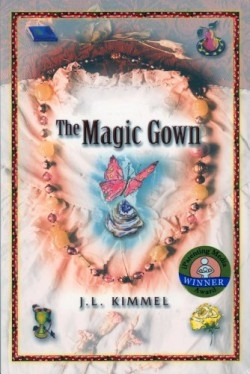The Magic Gown
Children who venture into magical lands such as Oz, Narnia, or Wonderland will follow Lilly eagerly on her quest to find Princess Anais, wearer of the Magic Gown, and restore “the tenth king” to his throne in The Land of Ten Kings and Roses. Guided by a cast of magical “star travelers,” Lilly enters a brilliantly-hued world that is as breathtaking as Dorothy’s arrival in Munchkinland after the unrelenting grays of Kansas.
A seagull drops a shell, “shimmering gold and pearled white with purple colored markings,” into Lilly’s hand on the day she moves to New Jersey, and she receives an anonymous package at her new home the next day. Inside a “red wooden box carved with hummingbirds and flowering vines,” she finds a packet of unidentified seeds that blossom into rainbow-hued roses: “a rosy-pink flower, a buttery yellow one, a violet purple and a cinnamon orange flower blossom.”
Lilly also meets the Finches, whose adopted son Tom disappeared while sailing his boat a year ago. When a bright blue swan pops out of a pot of soup, her prophecy that magic will happen when the “night is white” begins Lilly’s quest, aided by a dragon named Mr. Hugh Myrrh, tiny Chipzys, and a multitude of fairies and talking animals. Not all of the creatures are benevolent, though, and Lilly soon learns that Princess Anais is hunted because Queen Merciles, Moregrott, and his army of malodorous, color-draining Lacks want the Magic Gown for themselves.
Meanwhile, Tom, whose arrival in this land is its own story, has stowed away on Moregrott’s ship and helps Princess Anais escape. Whenever Anais is threatened, the gown protects her by cramping the hands of those who try to touch it. At the story’s climax, it transforms the Lacks into colorful dragonflies and the evil Moregrott into a noble tiger. Lilly and Tom finally meet and realize that each of them has a special destiny.
This is the author’s first book, and the illustrations are her work as well. Her impressionistic watercolors recall Manet and Van Gogh, spilling indiscriminately throughout the book in section breaks, chapter endings, and pictures of everyone Lilly meets. Captions would help readers connect these exuberant paintings to specific scenes, especially since the plot is confusing at times. Full-page illustrations, smaller paintings, and maps feature the doors, roses, and other motifs of the story.
Reviewed by
Elizabeth Breau
Disclosure: This article is not an endorsement, but a review. The publisher of this book provided free copies of the book to have their book reviewed by a professional reviewer. No fee was paid by the publisher for this review. Foreword Reviews only recommends books that we love. Foreword Magazine, Inc. is disclosing this in accordance with the Federal Trade Commission’s 16 CFR, Part 255.

